White Boules with Gilchesters Flour and a Poolish
Made in College on 26th January 2011
|
Material |
Formula [% of flour] |
Recipe [grams] |
|
1. Poolish |
|
|
|
Special CC Flour |
30 |
900 |
|
Water |
30 |
900 |
|
Fresh Yeast |
0.07 |
2 |
|
TOTAL |
60.07 |
1802 |
|
2. Final Dough |
|
|
|
Poolish [from above] |
60.07 |
1802 |
|
Special CC Flour |
50 |
1500 |
|
Gilchesters Pizza/Ciabatta Flour |
20 |
600 |
|
Salt |
1.8 |
54 |
|
Fresh Yeast |
1.8 |
54 |
|
Water |
36.67 |
1100 |
|
TOTAL |
170.34 |
5110 |
|
Pre-fermented Flour |
30% |
|
|
Overall Hydration |
66.67% |
|
Oven Profile: Use a deck oven set at 235°C, top heat 6.5, bottom heat 5. Apply steam set at 4. Turn heat down to 225°C after 15 minutes and bake a further 10 minutes. Open the dampers, and bake out a further 5 - 8 minutes, reducing the heat to 220°C.
Method:
- Prepare the "Poolish" 16 hours in advance and ferment covered at 21°C
- Combine all the final dough ingredients in a small spiral mixer and mix on slow speed only for 15 minutes. Scrape down the bowl as required
- Ferment in bulk for 45 minutes, covered, at 28°C.
- Scale and divide into 1000g pieces, and mould round.
- Place upside down in prepared banettons, and prove for 1 hour 45 minutes at 30°C, 80%rH.
- Tip out onto a peel and cut the top of the loaf for coburg style with a cross. Set in the oven and apply bake profile.
- Cool on wires
Large Boule with Gilchesters Farmhouse Flour and a Biga
Made in College on 26th January 2011
|
Material |
Formula [% of flour] |
Recipe [grams] |
|
1. Biga |
|
|
|
Special CC Flour |
28 |
840 |
|
Water |
16.8 |
504 |
|
Fresh Yeast |
0.07 |
2 |
|
TOTAL |
44.87 |
1346 |
|
2. Final Dough |
|
|
|
Biga [from above] |
44.87 |
1346 |
|
Special CC Flour |
50 |
1500 |
|
Gilchesters Farmhouse |
22 |
660 |
|
Salt |
1.8 |
54 |
|
Yeast |
1.8 |
54 |
|
Water |
49.9 |
1497 |
|
TOTAL |
170.37 |
5111 |
|
Overall Hydration |
66.7% |
- |
|
Total Pre-fermented flour |
28% |
- |
Method and Profile:
As above, except change cutting to cuts covering the whole of the loaf top; 5 parallel cuts.
The crumbshots of the finished loaf made with biga and farmhouse flour:
Good, honest and tasty bread. Not tried the white coburgs yet, but I have a loaf in the freezer ready to sustain us for next week.
As a ps. a Level One student wanted to make Tiger Bread on Friday. This is what we came up with as a joint effort. I'm hoping he'll go far!
All good wishes
Andy
- ananda's Blog
- Log in or register to post comments
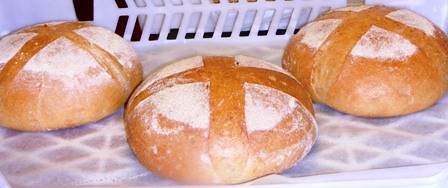
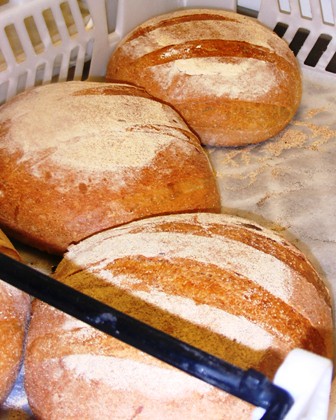
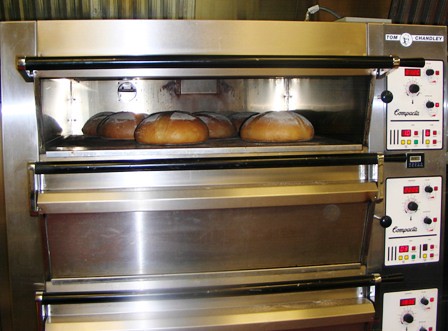

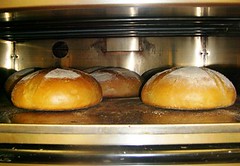
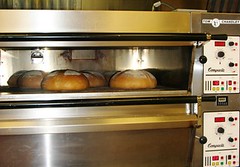
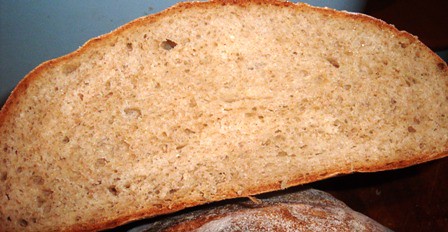
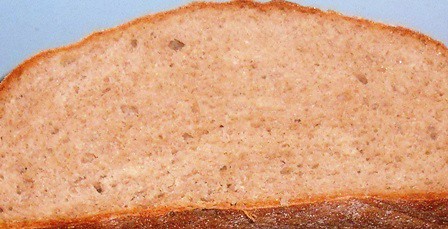

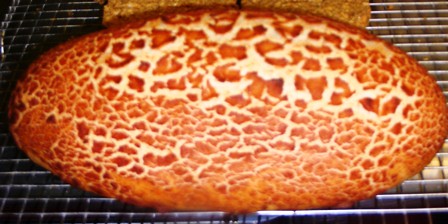
What great looking loaves, Andy! and, "WOW" I never seen " Tiger bread" that is amazing! Great work!
Is the flour what you used?
http://www.steenbergs.co.uk/product/1031/pizza-and-ciabatta-organic-strong-wheat-flour/23/52
Best wishes,
Akiko
Hi Akiko,
Many thanks for your kind words. I'll post more on Tiger Breads below, as other posters are also asking about this.
Yes, the link you post does show the self same flour I used. Here is a link to their own website: http://www.gilchesters.com/
Best wishes
Andy
Hello Andy, I really like your and your students' loaves...and the ovens!
I wanted to please ask what about 'Special CC Flour' (not sure what that is).
I love the Tiger Bread...this reminds me of a Dutch Crunch topping that I saw here on TFL: http://www.thefreshloaf.com/node/19559/dutch-crunch-bread;
I think Mr. Reinhart has a formula too in BBA? It looks like the Tiger Bread may have been created with something similar? It's really lovely. I've been keeping this idea in mind to bake for a couple of friends, who are of Dutch heritage, and it's encouraging to see the beautiful result your student achieved.
thanks from breadsong
Hi Breadsong,
Very good to hear from you.
Special CC [stands for Carrs Celebrated] is the premium flour produced by Carrs of Silloth, in the north west corner of England; website is here: http://www.carrs-flourmills.co.uk/silloth/
The company has a long history of importing Canadian wheat direct to the dock where the mill is based. This practice was begun by the mill's founder, in order to supply his bakery up the road in Carlisle and now a biscuit bakery owned by the giant United Biscuits.
The mill remains independent, uses very modern milling techniques and is the supplier of choice for Warburtons in the UK. There are 3 plant bakers controlling the UK bread market, and the other 2 firms are millers as well as bakers. Warburtons are controlled by the family, and employ farmers in Canada to grow high quality wheat for them.
Special CC is an all Canadian flour. I had a full tour of the mill with a lecturing colleague about 3 years ago. Ever since then I have supported Carrs by adopting them as supplier of choice for baking in our College. Last week, for the first time ever, I encountered problems with this premium flour. The immediate response from the mill was to uplift the entire batch and replace it; fantastic service!
So, for mainstream bakery teaching, I could not wish for a better range of flours to use so my students can expect the reliable results they need to keep their confidence bolstered.
Will post more on Tiger Bread below, but, yes it is the same concept as that covered by Peter Reinhart.
All good wishes
Andy
Hello Andy, I like knowing it's good Canadian wheat that is building your beautiful breads! Thanks for letting me know, and for your comments to Franko too about the Tiger Bread paste. I appreciate you taking the time.
Regards, breadsong
Are you selling the stuff, or giving it out? That's a lot of good bread I see baking.
I'm intrigued at both formulas and the fact that you chose a poolish for one and a biga for the other (with corresponding differences in the amount of water added in the final mix).
What's your understanding/take on the choice of which preferment to go with? I've noticed that nearly every pizza dough recipe I come across calls for biga, yet I ask myself: why not poolish given the greater extensibility it imparts?
Anyhow, beyond that particular case, what is it that determines for you which preferment you use?
As usual, great bake!
Best,
Larry
Hi Larry,
Yes we sell all the bakery products in our school. Is there a better way to showcase the work of my college students?
These breads, however, were my work [tiger was joint effort]. I was running a Foundation Degree bread assessment, and there was an excess of both biga and poolish. Not wanting to see it go to waste, I set too and made 10 large loaves of bread. They ended up being bagged by my fellow lecturing colleagues for a small fee.
With regard to choosing between the 2 different pre-ferments, I offer the following thoughts.
Firstly, I made the bread with what was available to me. I had to keep it as simple as possible, as otherwise it would have got in the way of teaching my students. So, I kept to 2 simple formulae which I could process without getting in anybody's way.
From a teaching point of view, most of my work with yeasted pre-ferments serves as an introduction for students. In most cases, these students are keen to get to grips with complex fermentation, but have little experience of doing it.
So, I introduce baguette and pain rustique with a poolish, and ciabatta and another boule made with the biga. I also make pizza with the biga.
I don't make any claims for this being the case, but I associate the poolish with France, and the stiff biga with Italy. So, I've chosen products representative of those countries and made them with the appropriate pre-ferment. For the English-style high crown pan breads, I use a pre-ferment which is, essentially, a stiff biga.
So, I don't really go as far as analysing different flavours, textures and other performance indicators. Of course, that would be fun to do. Maybe I'll use that for future development in the curriculum?
Thanks, as always for your kind comments
Best wishes
Andy
Hi Andy,
Beautiful boules! I really like the overall consistent profile on them, without the steep angled rise but with plenty of height across the entire loaf. Larry raises a good question about the virtues of poolish v biga. I've always considered it a flavour question more than anything between the two, poolish to me having a sweeter, wheatier flavour whereas biga seems to contribute a slightly sharper, tangy note to the dough, not sour, just a bit more acidic. I'm sure we'd both be interested to hear your thoughts on the two preferments.
Re: tiger bread We used to make a Dutch Crunch years ago and if I recall correctly we used rice flour, salt, scant amount of veg oil, blended for the dry mix, and then made a thin slurry with fresh yeast and water which we mixed with the dry to make a spreadable paste. Is that close to the topping on the tiger bread?
All the breads look wonderful, but you've made me very envious of your oven in particular. I want one!
Cheers,
Franko
Hi Franko,
Really good of you to stop by.
Yes, I was very pleased with the profile aspect of these finished loaves. I think the long slow mix in the spiral plus the really strong pre-ferments led to fantastic finished dough quality. From there it was relatively easy to create a production schedule which allowed me to bake these loaves immediately after all the students had finished baking their works.
Regards pre-ferments, see above comments to Larry. I just like to make breads with any pre-ferment for preference. I guess that is a potential departure from Calvel, but I much prefer complex fermentation to long fermented straight doughs. Again, a personal preference.
Your recipe for Tiger paste is spot on. I add just a touch of sugar to the paste too. I make the paste with equal weights of water and rice flour, so it can be coated onto the breads using a pastry brush. Allow the prepared loaves to sit for 5 minutes, then bake in the deck with a moderate amount of steam.
Yes, I deliberately wanted to post on using the deck oven. It truly demonstrates the superior loaf spring and profile I can achieve compared with my home oven. They cost the College £13,500! Bargain, I'd say
All good wishes
Andy
I am wondering how you get the cuts to open so cleanly. They look almost painted on with no ragged edges and a very smooth surface inside the opening. It looks amazing. -Varda
Hi varda,
thank you for your kind words.
For cutting the dough prior to loading, I use one of these grignettes: http://bakerybits.co.uk/Bordelaise-Professional-Lame-or-Grignette-P465334.aspx
I'm not really a master of the art, in comparison to some on TFL [David is very hot on this]. But this is a good tool for the job. The real secret, of course, is the way the loaf has sprung in the deck oven. So it is essential to achieve just the correct final proof levels, then see the loaves rise masterfully on the oven sole, in a steamy pressurised environment.
All good wishes
Andy
Hi Daisy_A,
I think I've responded fully in the above posts; I thought you might like the oven shots!
Colour-wise, these loaves do have a very pleasing aspect, although the shots are taken with 2 different cameras, and a number of different settings.
The russet burnish is evident in the boule with the farmhouse flour. The other bread has a pleasant more golden brown aspect to the finished colour.
Looking forward to eating the bread made with the poolish next week. The one with the biga is all but eaten up, so too the Tiger bread.
Very best wishes
Andy